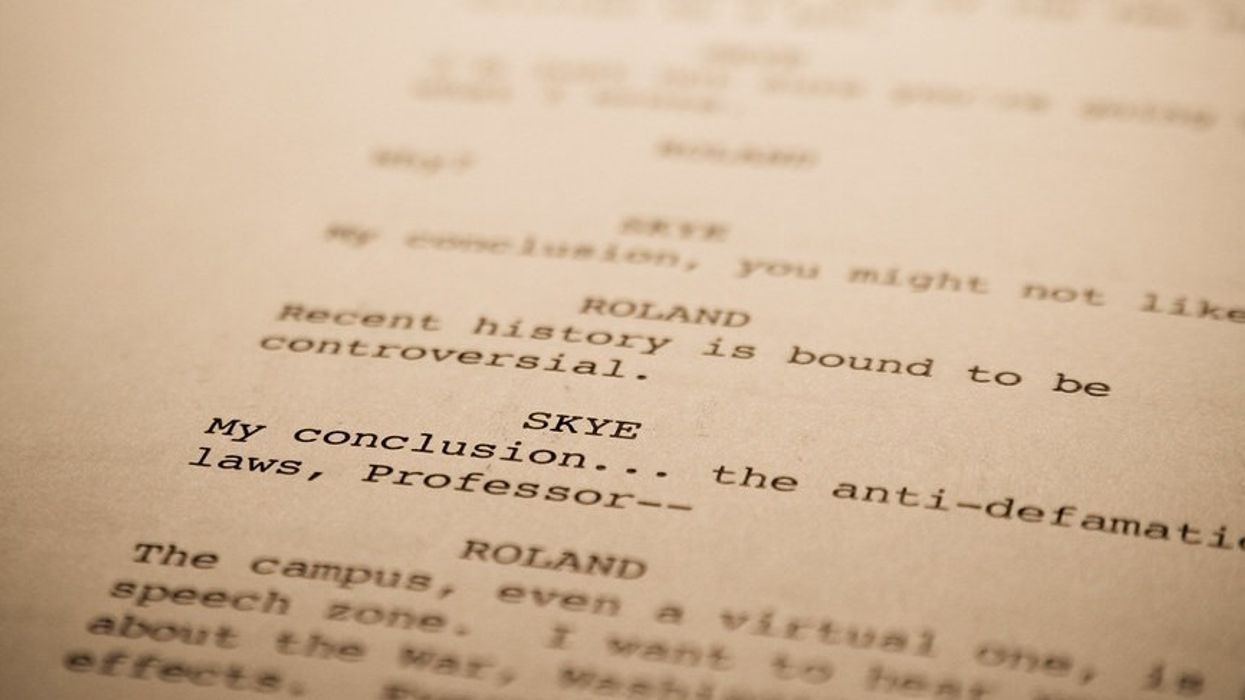Chernobyl Mastermind Craig Mazin Breaks Down All His Writing Tips and Techniques [LISTEN]
Craig Mazin drops some incredible knowledge on listeners in the latest episode of Scriptnotes.

As a podcaster, writer, and producer, Mazin has done some stellar work through the years, including creating and writing this summer's amazing miniseries, Chernobyl. He has always been a great resource to aspiring writers, and the latest episode of Scriptnotes is no exception.
In this episode, he discusses structure and character, with a overarching goal of tackling how to write a movie.
Dive in!
Screenwriting structure
Most of us will know about the hero's journey, Save the Cat, or Syd Field's screenwriting beats. But Mazin points out that most screenwriting structure beat sheets or diagrams approach the craft as fitting pieces together after the fact, which he says is the wrong way to look at things. You should be looking at it as creating something new, from scratch.
If you follow structure guidelines exactly, he says, you'll write a well-structured but bad script.
"Structure is a symptom of a character's relationship with a central dramatic argument," he says.
"Structure is a symptom of a character's relationship with a central dramatic argument."
In other words, if you're telling a good story, your beats will follow the character and his dramatic argument in a way that makes structural sense, because story beats tend to happen naturally. Don't think of it as plugging your screenplay into a template -- because then, you're locking yourself into a structure without thinking about the story first.
That inciting incident and midpoint reversal should still happen, but without the effort of basically working backwards from structure first.
What changes in a story?
"Story is about a change of state," Mazin says. And change happens in three ways.
The first change is internal -- a character's thinking and emotions. The second is interpersonal change -- how your character's relationships change. The third is external -- the basic plot, a start and finish.
Mazin says you should think about a story in terms of thesis, antithesis, synthesis. Each scene starts with a truth, which is then challenged, and a new truth emerges. And so on, until you have enough scenes for a whole story.
Don't forget theme
Theme is the glue that holds your story together and prevents your story from becoming episodic, or just a series of dull scenes.
Mazin points out that this should not just be a vague concept or idea, it needs to be something that you can argue. Take this scene from When Harry Met Sally.
Men and women can't just be friends. That's the central idea argued at the heart of When Harry Met Sally.
As you're starting out on a new script, you might have an idea or an image. But that's not enough. Your next thought should be about the central dramatic argument -- what is your story saying on a deeper, thematic level?
Mazin takes Finding Nemoas an example. The basic idea of Finding Nemo is simply that one fish needs to find another fish in the ocean. Easy! But on a deeper level, Mazin says, the movie is about how, no matter how much you love someone, you might have to let them go.
Mazin's key point here is that, in thematic structure, you're taking the character somewhere and teaching them a lesson. They are going from ignorance of the truth of your thematic argument to the embodiment of the argument through action. So in the beginning, in the character's normal world, your character will probably believe the opposite of your theme.
In the case of Finding Nemo, Marlin is happy to keep his son close and safe, at the risk of stifling him and causing resentment.
In a story, the inciting incident is meant to disrupt the character's world and stasis. Make sure this incident is tailored to your character to destroy his stasis specifically. In Finding Nemo, the inciting incident (Nemo's capture) is what jolts Marlin out of his comfort zone.
The dreaded second act
So after you've destroyed your character's world and stasis, what do they want? They want a return to that world of comfort. And this is what will propel you through the second act.
Many writers see the second act as a vast wasteland of story where it's easy to get lost -- which is kind of nuts, because that's where the bulk of your plot happens. That's where the journey occurs and relationships are formed and lost. It's also where the midpoint reversal happens, or the point where your character suffers a horrible obstacle that seems impossible to overcome.
Mazin suggests this is the place to reinforce your anti-theme. The character should experience beats that make them want to return to their stasis even more. He encourages you to really torture the character -- so go for it.
But then you also need to introduce doubt. Have your hero meet someone who believes the opposite of them, and nudge them toward a different way of thinking. Give your character a beat where they are somehow involved in the "right side" of your thematic argument.
This, Mazin says, is the reason for the midpoint. This is the point where the character might see that they've been living a lie, but then still are unable to change fully.
In Finding Nemo, that moment is the jellyfish frolic. Marlin sees for just a second that having fun, and not constantly worrying, could be a new way of life. But then Dory gets stung, and this moment slams him back to his old fearful self.
You really have to beat up your characters. It leads to incredible drama and gives your story somewhere else to go in the final act.
At this point, your character should be moving away from what they believed in the beginning, but they shouldn't fully embrace the "truth" of your theme yet.
"Keep thinking ironically"
Mazin says that your character's obstacles and story beats shouldn't be just random events that keep him from reaching a goal. They should be thematically related somehow to him and his central dramatic question.
I know I just wrote about Barry, but dang it, I have another chance to bring it up here, so I will.
(Spoilers for Barry season two.)
The thematic question of Barry season two is about identity -- that you can choose the version of yourself that you present to the world and make it your truth. You can let go of your old self and be someone new. Barry (played by Bill Hader) keeps returning to a memory from his second tour of duty as a Marine, when an enemy attack left him so unhinged and so enraged that he killed an innocent man.
Barry wrestles with his guilt about that moment throughout the season. He ultimately decides that people can change, and he doesn't have to be that version of himself anymore. But the instnat he learns that his old handler Fuches (Stephen Root) is in a local stash house, he immediately goes insane again -- and kills almost everyone inside.
But this time, the victim is not merely an innocent man. It's an entire group of men he spent the whole season training, including Mayrbek (Nikita Bogolyubov), a young guy with whom he had an emotional connection, a guy who was thankful for Barry's guidance. When Barry kills Mayrbek, the moment lands like a punch in the face. The regret is a thousand times worse. Barry is the same, but even more unhinged than anyone thought.
I know this is TV. It's still applicable to character work.
So if you can punish your characters, do so -- but make sure it matters emotionally, too.
The defining moment
The end of a script usually comes with the arrival of a low point, when your character's goal is totally in shambles and there is seemingly no point in going on. This should be when your character is most lost. Catharsis comes after with a defining moment that will bring them to synthesis.
"You're going to design a moment that is going to test your protagonist's faith in the theme."
"You're going to design a moment that is going to test your protagonist's faith in the theme," Mazin says.
The character has to face a moment where they prove that their thinking has changed, and they have to prove it through action. Mazin suggests that you give your character a chance to go back to the way things were, way back at the beginning, an easy way out -- and have the character reject it.
He returns to Finding Nemo. At the end of the movie, Marlin finally gets Nemo back, but then loses Dory in a fishing net. He has to choose to let Nemo go, even though they have just been reunited, in order to save Dory.
As Mazin points out, it's not just that Marlin lets Nemo go -- Nemo gets hurt and almost dies. (Torture your characters!) And the audience gets to see Marlin accept this. It's compelling because it shows he has grown throughout this story, and now he acts according to the theme.
The big takeaway from all this? If you approach story as a question of theme and character growth, and create moments that will challenge the character's beliefs, the beats will fall into place. Don't force yourself to work backwards from an outline. Work within your thematic question.
What's next? Start writing!
We've got lots of writing resources to help you continue your screenwriting journey. If you're in TV, you need to know how to write a show bible. If you're interested in how Pixar writes stories, we've got their 22 rules of storytelling. And there's nothing better than learning from the greatest scripts themselves. After you check out Chernobyl, take a look at screenplays for The Social Network, Pulp Fiction, and Up.
Source: Scriptnotes











